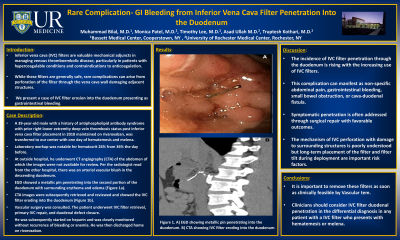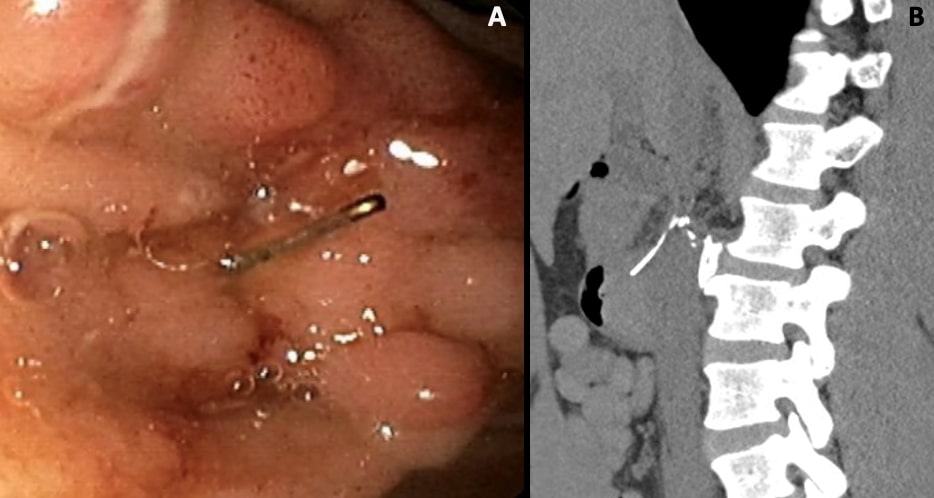Monday Poster Session
Category: GI Bleeding
P2480 - Rare Complication - GI Bleeding from Inferior Vena Cava Filter Penetration Into the Duodenum
Monday, October 28, 2024
10:30 AM - 4:00 PM ET
Location: Exhibit Hall E

Has Audio

Muhammad Bilal, MD
Bassett Medical Center
Cooperstown, NY
Presenting Author(s)
Muhammad Bilal, MD1, Monica Patel, MD2, Truptesh Kothari, MD2
1Bassett Medical Center, Cooperstown, NY; 2University of Rochester Medical Center, Rochester, NY
Introduction: Inferior vena cava (IVC) filters are valuable mechanical adjuncts in managing venous thromboembolic disease, particularly in patients with hypercoagulable conditions and contraindications to anticoagulation. While these filters are generally safe, rare complications can arise from perforation of the filter through the vena cava wall damaging adjacent structures. We present a case of IVC filter erosion into the duodenum presenting as gastrointestinal bleeding.
Case Description/Methods: A 39-year-old male with a history of antiphospholipid antibody syndrome with prior right lower extremity deep vein thrombosis status post inferior vena cava filter placement in 2018 maintained on rivaroxaban. He was transferred to our center with one day of hematemesis and melena.
On presentation, the patient was hemodynamically stable with an unremarkable physical examination. Laboratory workup was notable for hematocrit 26% from 36% the day before. At outside hospital, he underwent CT angiography (CTA) of the abdomen of which the images were not available for review. Per the radiologist read from the other hospital, there was an arterial vascular blush in the descending duodenum. Gastroenterology was consulted. EGD showed a metallic pin penetrating into the second portion of the duodenum with surrounding erythema and edema (Figure 1a). CTA images were subsequently retrieved and reviewed and showed the IVC filter eroding into the duodenum (Figure 1b).
Vascular surgery was consulted. The patient underwent IVC filter retrieval, primary IVC repair, and duodenal defect closure. He was subsequently started on heparin and was closely monitored without recurrence of bleeding or anemia. He was then discharged home on rivaroxaban.
Discussion: The incidence of IVC filter penetration through the duodenum is rising with the increasing use of IVC filters. This complication can manifest as non-specific abdominal pain, gastrointestinal bleeding, small bowel obstruction, or cava-duodenal fistula. Symptomatic penetration is often addressed through surgical repair with favorable outcomes. The mechanism of IVC perforation with damage to surrounding structures is poorly understood but long-term placement of the filter and filter tilt during deployment are important risk factors. Hence, it is important to remove these filters as soon as clinically feasible. Clinicians should consider IVC filter duodenal penetration in the differential diagnosis in any patient with a IVC filter who presents with hematemesis and melena.

Disclosures:
Muhammad Bilal, MD1, Monica Patel, MD2, Truptesh Kothari, MD2. P2480 - Rare Complication - GI Bleeding from Inferior Vena Cava Filter Penetration Into the Duodenum, ACG 2024 Annual Scientific Meeting Abstracts. Philadelphia, PA: American College of Gastroenterology.
1Bassett Medical Center, Cooperstown, NY; 2University of Rochester Medical Center, Rochester, NY
Introduction: Inferior vena cava (IVC) filters are valuable mechanical adjuncts in managing venous thromboembolic disease, particularly in patients with hypercoagulable conditions and contraindications to anticoagulation. While these filters are generally safe, rare complications can arise from perforation of the filter through the vena cava wall damaging adjacent structures. We present a case of IVC filter erosion into the duodenum presenting as gastrointestinal bleeding.
Case Description/Methods: A 39-year-old male with a history of antiphospholipid antibody syndrome with prior right lower extremity deep vein thrombosis status post inferior vena cava filter placement in 2018 maintained on rivaroxaban. He was transferred to our center with one day of hematemesis and melena.
On presentation, the patient was hemodynamically stable with an unremarkable physical examination. Laboratory workup was notable for hematocrit 26% from 36% the day before. At outside hospital, he underwent CT angiography (CTA) of the abdomen of which the images were not available for review. Per the radiologist read from the other hospital, there was an arterial vascular blush in the descending duodenum. Gastroenterology was consulted. EGD showed a metallic pin penetrating into the second portion of the duodenum with surrounding erythema and edema (Figure 1a). CTA images were subsequently retrieved and reviewed and showed the IVC filter eroding into the duodenum (Figure 1b).
Vascular surgery was consulted. The patient underwent IVC filter retrieval, primary IVC repair, and duodenal defect closure. He was subsequently started on heparin and was closely monitored without recurrence of bleeding or anemia. He was then discharged home on rivaroxaban.
Discussion: The incidence of IVC filter penetration through the duodenum is rising with the increasing use of IVC filters. This complication can manifest as non-specific abdominal pain, gastrointestinal bleeding, small bowel obstruction, or cava-duodenal fistula. Symptomatic penetration is often addressed through surgical repair with favorable outcomes. The mechanism of IVC perforation with damage to surrounding structures is poorly understood but long-term placement of the filter and filter tilt during deployment are important risk factors. Hence, it is important to remove these filters as soon as clinically feasible. Clinicians should consider IVC filter duodenal penetration in the differential diagnosis in any patient with a IVC filter who presents with hematemesis and melena.

Figure: Figure 1. A) EGD showing metallic pin penetrating into the duodenum. B) CTA showing IVC filter eroding into the duodenum.
Disclosures:
Muhammad Bilal indicated no relevant financial relationships.
Monica Patel indicated no relevant financial relationships.
Truptesh Kothari indicated no relevant financial relationships.
Muhammad Bilal, MD1, Monica Patel, MD2, Truptesh Kothari, MD2. P2480 - Rare Complication - GI Bleeding from Inferior Vena Cava Filter Penetration Into the Duodenum, ACG 2024 Annual Scientific Meeting Abstracts. Philadelphia, PA: American College of Gastroenterology.
